| 1 | Top of the Amazon bite tables |
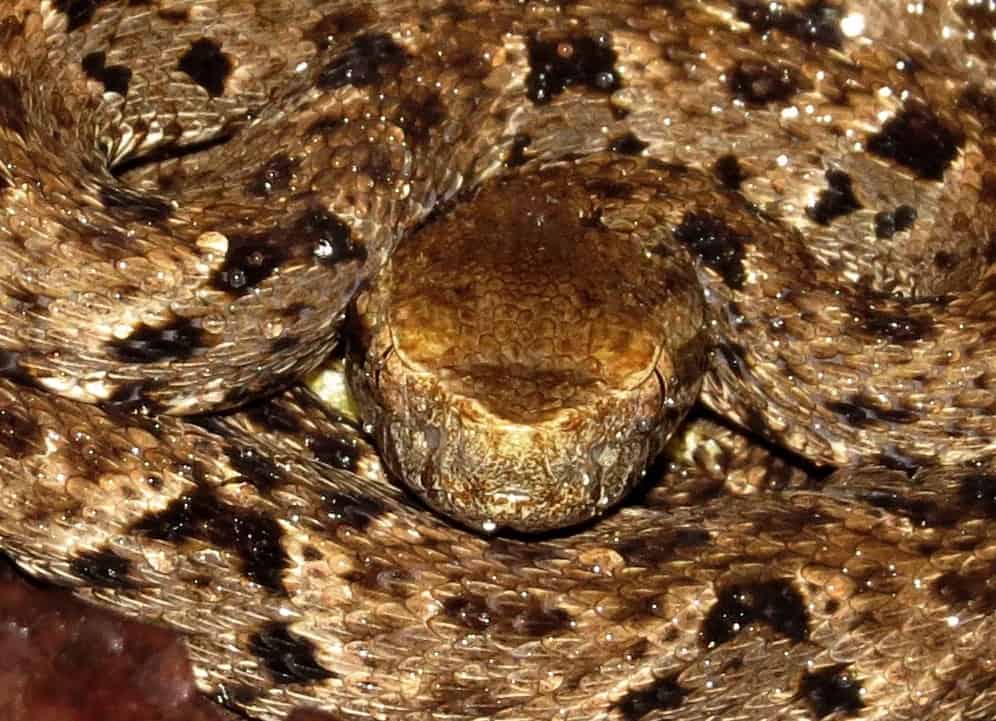
The Amazon rainforest contains dozens of venomous snakes. Entering without a torch and a phone for emergency evacuation is one of the most dangerous things you could do. Many statistics have been gathered, and they consistently show that one Amazon snake species rules them all for bites annually: the common lancehead, AKA Bothrops atrox.
This viper averages at 75-125cm, with a confirmed record of 172.3cm. Females are longer than males, and its patterns consist of subtle beige-brown shades, optimised for camouflage amid rain-soaked foliage. This species is found all over the upper half of South America. Statistics reveal that common lanceheads are easily the top cause of snakebite in French Guiana. In a 2021 study from the Brazilian Amazon, 9902 snake bites were recorded in data gathered from local hospitals, and 8436 of those were caused by common lanceheads. Various studies place the common lancehead as responsible for 90% of snakebites in Amazonian regions of Brazil.
While coral snakes pop up all over Brazil, they’re relatively timid and docile. Common lanceheads rarely hesistate to attack, sometimes hissing, but sometimes lunging forward without warning.
| 2 | Spontaneous bleeding specialist |
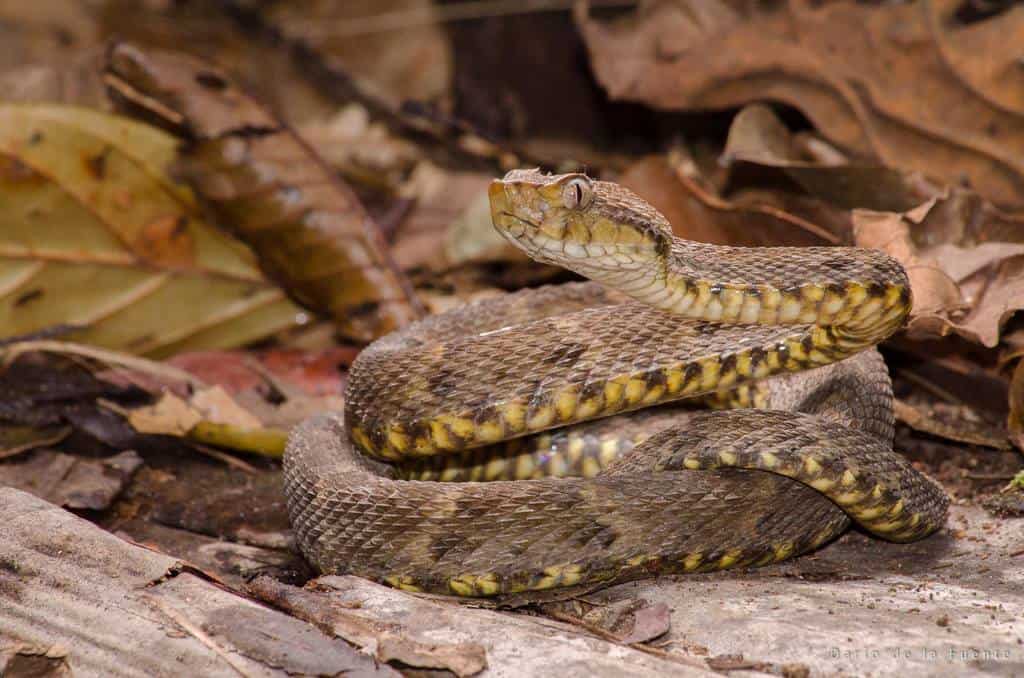
Common lanceheads mainly live in moist forests, and are extremely common in South America. They live east of the Andes, meaning that they’re absent from Central America, but their ranges starts in eastern Colombia and doesn’t let up.
Bothrops atrox is found in Venezuela, French Guiana, Trinidad, central and northern Brazil, eastern Ecuador, Suriname and eastern Peru. They’re extremely abundant because of their habitat flexibility: they appear in forests ranging from pristine untouched rainforest, to forest fringes degraded by loggers, to isolated tree fragments in villages. Common lanceheads also invade agricultural land, such as banana and coffee plantations, where farmers often fail to notice them lurking in leaf litter.
Unlike the coral snake family, common lanceheads produce virtually no neurotoxic symptoms, such as paralysis, laboured breathing and drooping eyelids. This snake specialises in spontaneous bleeding and severe local symptoms. The latter include swelling, severe pain, necrosis, blisters, flushing, and bruising. Systemic symptoms include vomiting, nausea and headaches, and that’s the non-lethal ones. Common lancehead victims are known to bleed from the gums and nose. A study from the Brazilian Amazon found that 8.8% of victims develop blisters.
| 3 | Double-edged toxins |
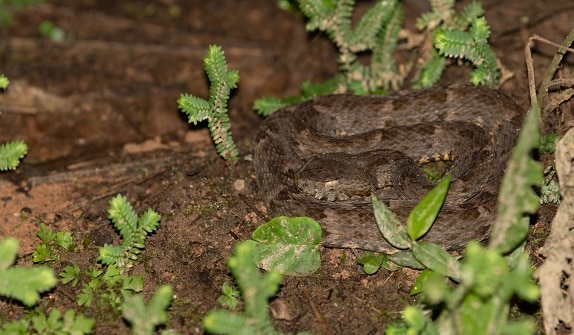
The main toxin class in Bothrops atrox is the snake venom metalloproteases (SVMPs), comprising over 50% of the mixture. Others include phospholipase A2s (PLA2s) and serine proteases (SVSPs). The SVMPs are enzymes similar to the metalloproteinases found in human skin, which recycle old collagen, but potentiated ever further to cause catastrophic damage. They’re largely responsible for the haemorrhaging powers of Bothrops atrox venom, directly targeting the physical structure of blood vessels.
Post bite, SVMPs rapidly bind to receptors in the capillaries and venules (the tiniest blood vessels). There, they corrode structural elements like type 4 collagen and laminin. The microvessels distend and weaken, and ultimately burst, causing the spontaneous bleeding that common lanceheads are famous for. But SMVPs have a double haemorrhaging function that make them almost unstoppable. They’re also procoagulants, which lead to venom-induced consumption coagulopathy (VICC) in victims.
Rather than directly destroying blood clotting factors like fibrin, as anticoagulants do, the metalloproteinases dramatically increase their production. Specifically, they act on factor II and factor X, enzymes involved in the conversion of fibrinogen to thrombin. By dramatically depleting their stocks, this removes the raw materials required for ordinary wound clotting.
| 4 | Survivable venom (just) |
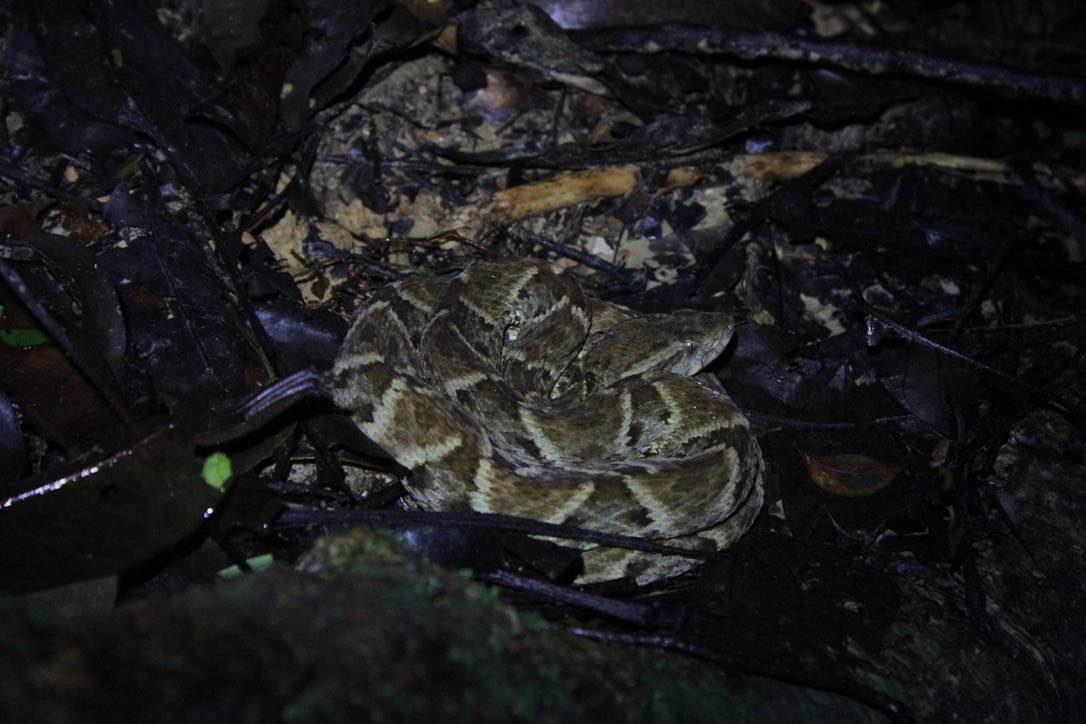
The LD50 score is the scale used to assess a snake venom’s toxicity milligram by milligram. It refers to the quantity required to kill 50% of tested subjects (typically mice) it is injected into. Black mambas score 0.05mg, while eastern coral snakes score 0.2mg. Common lanceheads are significantly milder at just 1.1-4.9mg. Likewise, they have fatality rate of just 2%. An eastern diamondback rattlesnake reaches an estimated 20%, without antivenom. But common lanceheads can cause lasting injuries, including life-changing amputations and deformities resulting from necrotic flesh.
The main cause of death, if it happens, is kidney failure (rather than lung failure in neurotoxic snakes). One study involved 127 bite victims from Manaus state, western Brazil. 38.6% of these developed acute kidney injury (AKI). 61.2% reached the milder stage 1 AKI, 34.7% stage 2, and 4.1% stage 3. The worst affected were patients below 10 and above 60 years of age.
The study also found a direct correlation between circulating levels of venom in the bloodstream and the severity of kidney injury. All snakes inject varying quantities of venom. Common lancehead yields range from 100-200mg, with a maximum of 342mg. Whether you die from this Amazonian terror may depend purely on luck. Dry bites have also been recorded with this species.
| 5 | Good news: antivenom is everywhere |
Common lanceheads contain several unique toxins. The main metalloprotease is Batroxrhagin, while others include batroxase and Atroxlysin-Ia. There’s also a class of toxins which directly trigger severe inflammation: eicosanoids. This contributes to the local swelling and pain. The PLA2s are myotoxic, assaulting muscle tissue, causing the lysis of cells, when the contents leach. The immune response to these “foreign bodies” increases the inflammation of adjacent tissue even further. Common lancehead venom is a never-ending soup of nastiness.
One victim suffered a stroke, even when receiving antivenom. Luckily, death is not only rare, but antivenom is stocked in almost every hospital. In Brazil, direct elixirs for common lanceheads are rarely used. The country’s common, mass produced pitviper antivenom consists of antibodies raised against 5 Bothrops relatives: the jararaca (50% of the mixture), jararacussu (12.5%), crossed pitviper (12.5%), Bothrops moojeni (12.5%), and Neuwied’s pitviper (12.5%).
While a couple of more negative studies exist, the majority found that this antivenom succeeds against Bothrops atrox too, due to large toxin overlap. For example, a 2017 study gave mice a vial 45 minutes after a common lancehead bite. Swelling and muscle necrosis was prevented, and their depleted fibrinogen (blood clotting material) was restored.
| 6 | Endless colour morphs |
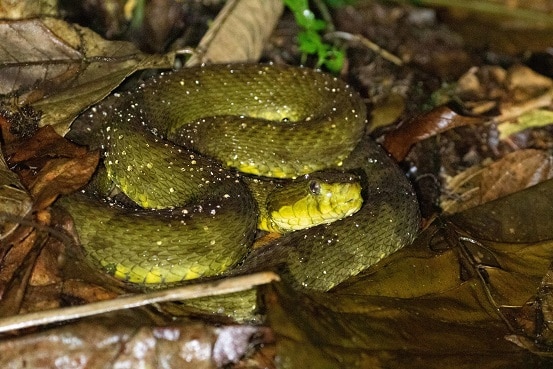
The common lancehead is a master of camouflage. When positioned on a fallen bed of leaves in a rainforest, they’re incredibly difficult to spot, even when on a dedicated hunt. To aid this camouflage, they have immensely varying appearance. Common lanceheads are never a bright pastel orange or green. But they can be stone grey, light brown, soil brown, almost beige, or with yellow stripes. Their goal is to match different forest substrates: soil, rotting logs, drier ground, pale golden leaves, etc.
Consistent features include a snout which isn’t upturned, vertical pupils, and a dark, sometimes black tongue. Juveniles have a bright yellow tail tip, designed for luring in frog prey, which mistake it for insects. This fades into adulthood. Camouflage is part of Bothrops atrox’s immense danger, as farmers work around them, busying themselves with harvesting coffee beans, not realising they’re there.
Bothrops atrox usually has a dark stripe extending behind the eye, though occasionally this doesn’t touch the eye. Their patterns range from thick stripes to trapezoids. However, a mostly consistent feature is a pale outline on each side, like the trapesoides are faintly glowing.
| 7 | Folklore and mimics |
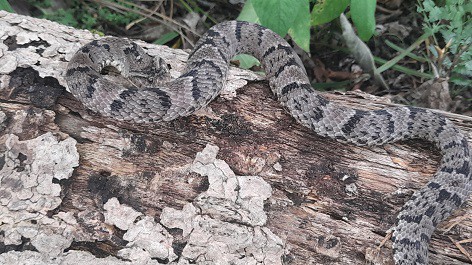
Severe venom doesn’t just help the owner to survive and thrive, but neighbouring snakes. Common lanceheads have a mimic which is riding their coattails to success: the false fer-de-lance, AKA Xenodon rabdocephalus. At a distance, its patterns are almost indistinguishable, even down to the fine glow bordering the patterns. The mimicry is so effective that no sane person would approach them, and bird predators are probably even more easily confused.
Xenodon rabdocephalus reaches 102cm, and has a mild, insignificant venom of its own. It lives in both Central and South America, meaning that it mimics both the common lancehead and the fer-de-lance further north. Adding to the confusion, Xenodon rabdocephalus is another forest dweller.
Common lanceheads are a magnet for superstition in local villages. Certain woodsmen swear that before drinking water from a stream, the jergón (as they call it) must deposit its venom on a nearby leaf. It will empty its entire venom gland into a mini pool which it can later reabsorb. Woodsmen believe that if they snatch this venom stash and toss it aside while the common lancehead is distracted, the snake will wither and die.
| 8 | Nocturnal and ground-dwelling |
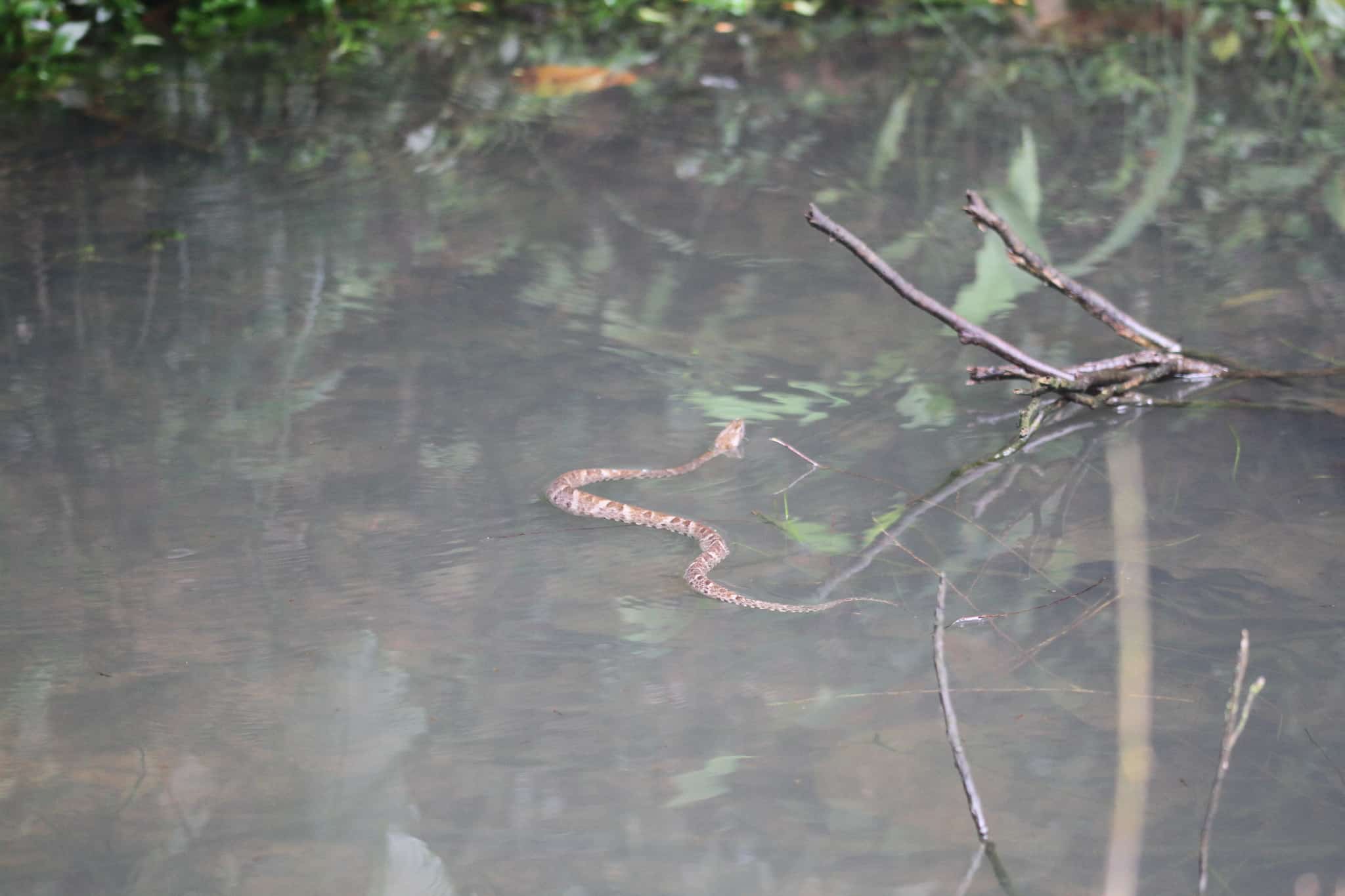
Bothrops atrox is a species of wet forests with abundant rainfall. They prefer forests closer to sea level, ranging from 0-940 metres. It’s rare to find them in cloudy, mountain forests, like a black speckled palm pitviper.
While not a semi-aquatic snake, common lanceheads correlate with water bodies, being up to 6.4 times more common near streams, forest pools or swamps. A 2001 study from Brazil revealed some hard, technical habitat data. The first was that Bothrops atrox was much less commonly sighted during the dry season. The number of sightings had a strong correlation with rainfall, but less so with humidity and not at all with temperature.
Common lanceheads were a heavily nocturnal snake, though not 100% strictly. Over 5 years of study, 79% of encounters were by night, versus 21% by day. Their most active period was from 18:00 to 22:00, before activity fell off a cliff until midnight. This post sunset activity has a deadly correlation with when humans are still awake, explaining the attacks.
| 9 | Lurks near fallen fruit |
At night, 66 lanceheads were discovered coiled in clear posture, out of 77 for which their activity was listed. 11 were moving, some flecking their tongue vigorously to detect prey. By day, the snakes were either moving without flecking their tongues, or coiled up in some deep shelter. This included within leaf beds, rotting logs, or natural buttresses.
Two common lanceheads were radiotracked, for 8 and 16 months. By day, they were almost always hidden in some deep forest stash. The scientists found that by day, common lanceheads were less prone to strike defensively.
Another discovery was connected to trees: juveniles often rested on branches and bushes, while adults mainly stuck to the ground. When adults climbed trees, it was to heights of just 5-150cm. Some common lanceheads were spotted lurking under buriti palms, surrounded by fallen fruit. They were possibly waiting to ambush curious rodents, like the Central American bushmaster, which waits amidst fallen welfia tree fruits. The common lanceheads were found in various forest types: dense, closed canopy forests with a sparse understory, and humid lowland swamp forests.
| 10 | Diet: super-flexible |
Common lanceheads are immensely flexible in their diet, another reason why they’re spread so far and wide. Our first study used 107 preserved common lanceheads, gathered from 1973 to 1975 in Para state, Brazil. The prey consisted of 44% frogs, 29% mammals, 11% lizards, 7% snakes, 5% centipedes, and 4% birds. There was every rainforest meal you could dream of (except maybe monkeys).
Bothrops atrox also eats fellow snakes, and they seem to love one species: the black-headed snake (Tantilla melanocephala). In the study above, this made up 3 of 4 snake prey identified; the last was an unidentified colubrid. An 80cm annulated catsnake (Leptodeira annulata) was also dragged from a common lancehead’s stomach.
A 2020 study was even more in depth, using 612 common lanceheads. Adults ate 56.3% mammals, 28.1% lizards, 9.4% frogs and toads, and 6.2% arthropods. Juveniles ate 44% lizards, 20% mammals, 10.7% frogs and toads, 6.6% snakes, and 16% arthropods. The common lancehead was immensely flexible, but there was a large shift from reptiles towards mammals with age. This is similar to most rattlesnakes.
